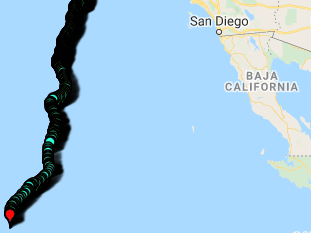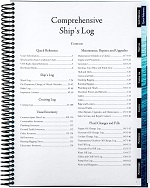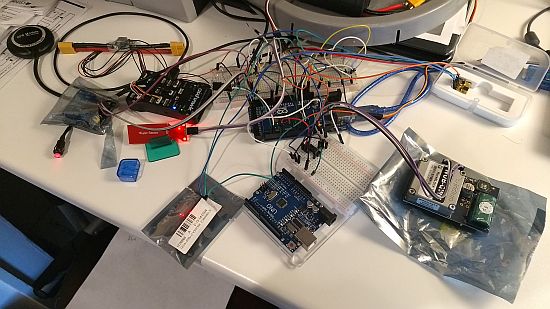The Build
What electronics are integrated into LOCARB?
Arduino Mega
LOCARB will use an Arduino Mega 2560 micro-controller (aka. companion computer) to control all the other aspects of the voyage such as motor speed control, solar/battery health monitoring, maintenance operations, acting as a watchdog (such as rebooting the navigation controller), and processing the required sensor data. The Arduino will organize the data to be sent by satellite modem to a server, and allow vessel health and location to be tracked.
Navigation (Pixhawk 2.4.8)
LOCARB navigation is based on of open source Ardupilot software with a Pixhawk 2.4.8 flight controller as its hardware base. The pixhawk controls the GPS, compass, telemetry, IMU, and rudder servo. Being an Ardupilot based navigation system, freely available ground control software (such as Mission Planner) makes for creating way-points simple, and allows for easy two-way communication with the autopilot. Two-way communication with wifi, radio, and satellite modem, are all options which are already supported with the Ardupilot platform.
Communications (Rockblock modem using Iridium SBD)
Bi-directional communication is vital for tracking boat health variables and location tracking. Since the boat will be out of range from cellular or wifi signals, a satellite modem will be used for communication. Using a Rock Seven RockBlock Iridium network satellite modem, we are able to achieve bi-directional communication directly to and from the Arduino via Iridium SBD (Short Burst Data).
Motor Control (Arduino with ESC)
The Arduino Mega micro-controller uses the servo library to control an RC Electronic Speed Controller or ESC. Modulating PWM pulses to the ESC allows the Arduino to control the desired throttle response. Testing was done with a bench power supply and power meter to find the data (power consumption) required to size the solar power system.
Sensors
LOCARB seeks to minimize complexity by utilizing as simple a code base as possible with the goal of being as “bug free” as possible.
Currently, there are sensors for:
Temperature (DHT22 and DS18B20):
- Battery compartment temperature
- Electronics compartment temperature
- Motor/Speed controller compartment temperature
- Rudder Servo Temperature
Humidity (DHT22):
- Arduino/Navigation compartment Humidity
- Motor/Speed controller compartment Humidity
- Battery compartment humidity
Voltage monitoring (Pixhawk Power Module and voltage divider via Arduino):
- Ability to monitor battery SOC
- Ability to monitor input voltage from solar panels (TBD)
- Ability to determine solar amperage readings (TBD)
Tilt switch (SW520D):
To determine if boat is currently and or has capsized.
Many autonomous trans-atlantic crossings have boats that just fail to respond, leaving much to the imagination. Did the boat run out of power? Did the boat get bitten by a shark? Did the boat spring a leak? My hunch is that many boats capsize and the antenna used for sending tracking data becomes submerged. This stops communication and the boat dies a slow death from lack of sunlight on its solar panels.
Leak Sensor (Cheap liquid level sensor off Ebay)
LOCARB will integrate a leak sensor to determine if there is a water leak. If it detects one, ill have a better idea of why the boat no longer responds given enough time 🙁
Camera
Totally unnecessary but a no-brainer to equip, is a camera to record footage throughout the journey for playback in the unlikely event of vessel recovery after a completed or failed crossing.
To do this, I will use a Samsung Galaxy S4 modified to turn on when power is applied to its USB port. It will run the IpWebcam Pro app with additional scripts configured so it will run at boot, begin taking photos every 10 seconds, and upload them to this website by ftp. Of course, this upload will only occur when close enough to body of land with an AT&T cellular network (thanks to freedompop).
Solar Panel Cooling
Advice from the creator of Seacharger commented that keeping the solar panels cool will make a noticeable difference in power generation (there are also several studies which support this). With that in mind, I’ve purchased (to test) a small 6v solar-powered water fountain pump which will hopefully spray water over the panels whenever the sun is bright enough to power the fountain. My hope is that with greater solar radiation, a larger volume of water will be sprayed on the panels keeping the panels cooler. I am concerned that the motor may cause interference in the compass and other miscellaneous sensors so pump placement will need to be carefully considered.
I’ve since come up with a more elegant solution using passive cooling. I’ll mount the solar panel on a cut to fit plastic pallet which has a mesh platform. The airflow provided by the non-solid surface and contact with water should keep the solar panel much cooler even in direct sunlight.
LoCARB REFRESH:
What are LOCARB’s power specifications?
- 4S10P Samsung 30Q 18650 Battery Pack with cheap 40a amazon BMS
- 110W SUNPOWER flexible solar panel (Testing with the Kingsolar recovered panel showed only 1.5-2 amp average output, damaged)
Victron BlueSolar MPPT 75/10 Charge controller with VE.Direct BT dongle for testing- DROK 90483 8A/100W DC-DC Buck/Step Down Converter (to replace the MPPT controller)
What are LOCARB’s Specifications?
- Battery/Motor Pod (4″ ABS Pipe using 1/2″ PVC pipe as struts to connect to hull)
- Foam filled Displacement Hull with 2 x 4 drilled hard-point backbone (6′ in Length 9.5″ tall)
- Max speed 1.5kts
- 70lbs on land, 40-50lbs on water (motor pod is almost neutrally buoyant with 5-10lbs added ballast).
- 4.75 x 4.75E black carbon fiber eBay propeller
- 1/2″ PVC tubing used for struts (filled with epoxy and a 1/4″ steel rebar), and wire runs.
- Cantex electrical box for electronics enclosure
Custom Magnetic coupling (motor to prop shaft)- GARTT ML4112 320KV BLDC motor (primary propulsion)
- Direct Drive Prop to shaft coupling submerged exposed to salt water
- 16v 300W Underwater Thruster (backup propulsion) from amazon
- 13-26 Watts Total Power Draw
FIRST LAUNCH LOCARB:
What are LOCARB’s power specifications?
- 12v 105ah AGM Battery (H9-AGM Autocraft Platinum Battery)
- 120W flexible solar panel (Kingsolar 120W Sunpower Solar Panel from Amazon)
- Victron BlueSolar MPPT 75/15 Charge controller with VE.Direct BT dongle for testing
- 28 hours of 100% continuous motor operation before needing a recharge (from full battery).
- 5.5 Days of standby life without motor running before needing a recharge (from full battery).
What are LOCARB’s Specifications?
- Battery/Motor Pod (10″ thinwall PVC Duct using 1/2″ PVC pipe as struts to connect to hull)
- Foam filled Displacement Hull with 2 x 4 drilled hard-point backbone (6′ in Length 9.5″ tall)
- Max speed of 2 knots actual
- 125lbs on land, 40-50lbs on water (motor pod is almost neutrally buoyant with 5-10lbs added ballast).
- 4.75 x 4.75E black composite ebay propeller
- 1/2″ PVC tubing used for struts (filled with epoxy and a 1/4″ solid carbon fiber rod), and wire runs.
- Cantex electrical box for electronics enclosure
- Custom Magnetic coupling (motor to prop shaft)
- 2.4a max current draw @ ~15v



